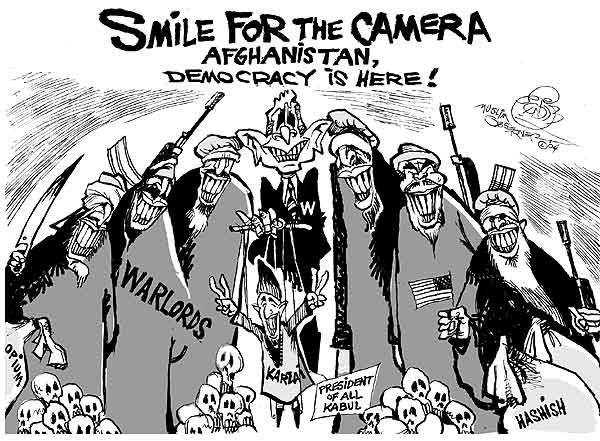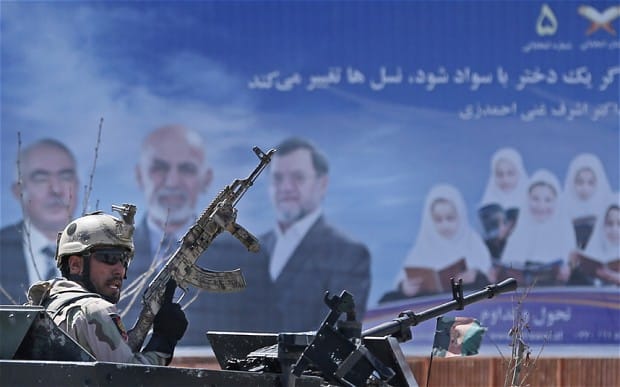The 2014 Afghan presidential election reveals the dual quality Achille Mbembe described in Politics as a Form of Expenditure[i] as, both, the domestication of violence and the threat of war over the capture and distribution of power. Both have played an important role in shaping the election process in terms of voter mobilization before 14 June, the day of the 2nd round of presidential elections, and has since then come back to haunt Afghanistan and bring dissent to the core of the community. Furthermore, two forms of election mobilizations have been crucial for the election outcome: an external form, by painting the political opponent as a security threat not just to the society holding the elections but to the whole region; an internal form, by mobilizing the untapped reservoir of voters in the rural zones, particularly women and youth, which in most countries are crucial to capture and maintain power. Both have relied on the opportunities offered by an important transformation of public space, especially the emergence of a TV debates, social media and the increasing circulation between the towns and the countryside.[ii]
Since 14 June, elections as domestication of violence has fluttered into my e-mail box on an almost daily basis day, for example, in the form of the UNAMA press statements. UNAMA has put in place a series of institutions and languages for deliberation and negotiation, an anti-politics machine of sorts,[iii] where questions of war and power are transformed into “candidates’ technical concerns” about the process of auditing of the election results.[iv] The presidential candidates have adopted this language and publically haggle over a whole range of technical issues, from how many votes will be recounted, to the separation of fraudulent from valid votes to dealing with similar handwritings on election checklists and result sheets from different provinces.
The language of domesticating violence immediately mingled with the threat of war and division. As a means to build leverage and assure a maximum share of power in the new Afghan government, supporters of both candidates diffused threats of war.
In its internal form, shortly after the 2nd round of elections produced the result of Ghani in a comfortable lead, the specter of insurrection started to haunt Kabul as rumors circulated about groups arming themselves to protect the status quo through force. In its external form, for example, Balkh provincial governor Attah Mohammed Noor addressed an international audience through foreign media, such as the Washington Post, in mid-August to warn about the potential of a coming insurrection “if the vote recount was one-sided or fraudulent”[v].
This appeared to me as a reversal of the situation before the 2nd round of elections when the specter an insurrection was coming from a different corner of town. After Abdullah Abdullah won the 1st round of the Afghan presidential elections, the word on some streets was of a coming insurrection in rural Pashtun areas if Abdullah would also win the second round, with the immediate specification, that insurrection meant the Taliban being at the gates of Kabul within a few days.
Does the focus on the threat of war and division, the focus on the “sublimation of violence by means of elections” conceal what could also be seen as a genuine competition, a domestication of violence and rejection of war? What happened, too, between the first and second rounds of the elections was simply a strong mobilization in rural Pashtun zones, tapping particularly rural women and the youth, the reservoir of postcolonial power. [vi] This mobilization reflected the fear of many Pashtuns of double trouble at the national and the local level: at the national level because Afghanistan has always been ruled by a Pashtun and this should continue to be the case; on the local level, because Abdullah Abdullah winning the presidency would mean being dominated, or ignored, for another five years by his long standing allies. In the southeast provinces, Abdullah Abudllah’s local allies happen to be the local opponents Pashtun tribal elders; in the east, they are the increasingly unpopular mujahideen turned businessmen. This potential double trouble in national and local politics was definitely more of a nightmare for many than going through the hassle of organizing voter registration cards and facilitating transportation from the villages to the polling centers on Election Day for the entire community, including the women.
It’s a numbers game, and even in conservative and patriarchal southeast, mobilizing the women’s vote was one of the ways for the rural areas to contribute to defeat Abdullah and his local allies.
Mobilizing the rural zones from the east to the south needed another form of domesticating violence, the buy-in from the Taliban. After the 14 June Election Day, stories circulated quickly about successful and unsuccessful deals with the Taliban, nothing the Taliban leadership officially approved of, but arrangements with village-level commanders not to interfere with the voting. The success of the local deals in rural Pashtun areas seems to have been as varied as Afghanistan’s checkered political landscape, differing from village to village. Where local deals were possible, people mobilized strongly for Ashraf Ghani, either as part of organized campaign teams or on their personal initiative, and those who could afford it used their own cars to drive around relatives and neighbors to the polling stations, sometimes to more than one, all day long. Some were organized, some did so spontaneously but in most cases there was a strong sentiment that this Election Day had been important and that they played an important role in mobilizing. Even now, two months after the elections, they tell stories of Election Day, not without pride, about eating the warlords’ food at their campaign rallies and taking their money but voting for the other candidate. Some campaigners recounted how they played a double game, officially mobilizing for the candidate who was paying them but secretly telling people to vote for the other.
But the capture and division of power is proving more and more difficult, and what seemed like a triumph of the domestication of violence manifest in the impressive election mobilization has returned to the prospect that the political struggle will be settled by force. The specter of war has returned to haunt society and bring dissent to the core of the community.

References
[i] Mbembe, A., 2006. On politics as a form of expenditure, in: Comaroff, J., Comaroff, John (Eds.), Law and Disorder in the Postcolony. University of Chicago Press, Chicago, pp. 299–335.
[ii] Ibid. p.317.
[iii] Ferguson, J., 1994. The Anti-Politics Machine: “Development,” Depoliticization, and Bureaucratic Power in Lesotho. University of Minnesota Press, Minneapolis.
[iv] UNAMA Press Statement, KABUL, 1 September 2014
[vi] Mbembe, A., 2006. p. 316.






Very Well written, however, it’s more of a hegemonizing the state structure and democratic process, to keep the ethnic superiority in play. There wasn’t any kind of deal with the Taliban whatsoever. How in a province the voters percentage goes up by 400% and more than the legitimate voters population of the province? That’s how the Pashtuns try to keep their dominance in Afghanistan through fraudulent votes.